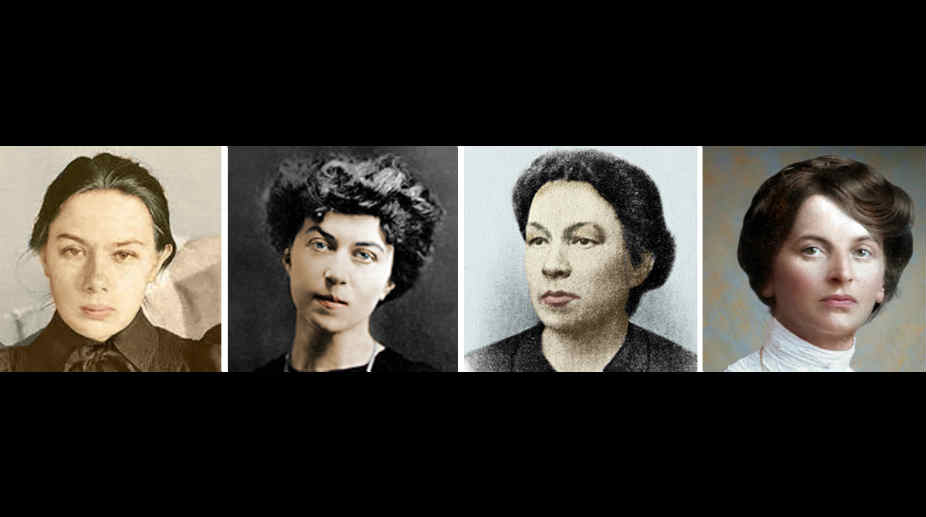The 1917 October Revolution was the catalyst that changed the course of Russian feminism. The new Soviet state had promised a radical social transformation to bring about full equality of women in economic, political and family life within a legal framework and civil codes that extended full citizenship to women. The Communist Party set up the Zhenotdel (Women’s Section of the Central Committee) to work among women to increase their participation in public affairs and to eradicate illiteracy. The Bolsheviks changed marriage and divorce laws. The absolute right to divorce was granted in 1917, hoping that a new kind of marital union based on freedom and equality would replace the traditional one. It also provided for equal division of property in the event of divorce. Abortion was legalised.
Nadezhda Krupskaya (1869-1939), Lenin’s wife, Aleksandra Mikhailovna Kollontai (1872-1952), Inessa Armand (1874-1920), Konkordiia Nikolavna Samoilova (1876-1921) were the leading women Bolsheviks. They were keen to improve women’s condition by paying attention to their education and employment, and getting a better deal for the working woman. Krupskaya’s main focus was on the education of women. In 1900, she wrote a pamphlet, entitled The Woman Worker, in which she strongly advocated the need to organize women within the Bolshevik faction. She favoured birth control, so as to spare women the psychological trauma as well as the physical risks of abortion.
Advertisement
Samoilova, like all Marxists, argued that women workers shared similar problems as their male counterparts. She took steps to organize the International Women’s Day in February 1913. Armand, along with Krupskaya and Kollontai, was the joint editor of Rabotnitsa (The Woman Worker). During World War I, she began to work on a pamphlet on the role of women in Communist society. She sent the draft to Lenin, which he rejected on the ground that it failed to distinguish the proletarian way of life from that of the bourgeois; hence, it was never published. Samoilova, Armand and Kollontai established the Zhenotdel in August 1919 to coordinate party work among Russian women. Kollontai helped in editing Zhenotdel’s theoretical journal, Kommunistka (The Communist Woman).
The most important Soviet feminist, Kollontai explored four broad themes in The Social Bases of the Woman Question (1908), namely economic independence, marriage and family, care for pregnant women, and women’s political rights. She believed that economic subordination led to women’s subjugation. She was equally aware of the miserable conditions of working women, and produced statistics from various countries to substantiate her claims. She felt that women were paid less because society undervalued their labour in comparison to men. Male employees assumed that they were the sole breadwinners, and that women work for various reasons other than economic/financial need. Unless there was a recognition of equal pay for equal work, women’s economic status would not improve. On the issue of family and marriage, Kollontai contended that the bourgeois family arrangement must be rejected, for it was coercive and obsolete.
She rejected the idea of free love under capitalism, for that would only compound the sexual exploitation that women were routinely subjected to. Sexual love between adults would be based on three principles ~ equality in mutual relations, mutual recognition of the rights of the other, and comradely sensitivity. Unlike many socialists and Marxists, she never wanted the abolition of marriage, and was convinced that spontaneous and unfettered sexual relationships were only possible with fundamental economic change. She believed that revolution would fundamentally alter human relationships. She supported women’s enfranchisement, for that would make them politically active. Like Engels and Bebel, she believed that the private family would give way to the collective, private childcare would give way to joint responsibility. She advocated public financing of child-bearing and child-rearing.
She maintained that a socialist society would create a new morality, and that relationships need not be monogamous or permanent. Love would be the basis of the man-woman relationship. Women would not be economically dependent on men, and children would be the responsibility of society. Her detractors accused her of unrestricted promiscuity. She also hoped for a transformation in the human psyche and was convinced that if that happened, the problems between the sexes would be resolved. Kollontai insisted on the need to combine reforms for women and the goal of a socialist revolution. She was convinced that women could improve their lives and help in the socialist cause simultaneously, for socialism and feminism had the same objectives, and were essentially complementary.
Kollontai saw the new communist woman as a liberated individual, sexually active, living in a comradely marital union, in which economic calculations would be subordinated. She explored changes in social and sexual relationships under socialism in Theses on Communist Morality in the Sphere of Marital Relations (1921), Sexual Relations and the Class Struggle (1921) and Make Way for Winged Eros: A Letter to Working Youth (1923). She examined the relationship between women’s oppression and the nuclear family. She was convinced that women’s emancipation and true social equality between the sexes were possible only in a socialist society. She argued that family, attitudes of freedom and personal relationship were socially conditioned.
However, her arguments were disapproved by most Russian working-class women and Lenin. Both Kollontai and Zetkin maintained that if socialist women could fight for reforms on behalf of their sex, it would help the proletarian movement by raising women’s consciousness and participation. Lenin dismissed the idea of spontaneity in human relationships altogether. He had very little time for himself, and was obsessed with matters political and the need to bring about a revolution in Tsarist Russia. His suspicion of spontaneity and individual initiative proved to be the major impediments to the liberation of both men and women in the former Communist world. Stalin (1879-1959) personally did not believe in the equality of women. His views on the family, home and on the role of women within it were conservative. He invented the phrase ‘heroine mother’ to describe a woman who had a number of children.
The German Social Democratic Party (SPD) was the first socialist party, prior to World War I to advocate universal suffrage and renounce revolution as a method of struggle for achieving working-class aims and this made them pay increasing
attention to women’s suffrage. In 1905, Finland was the first country to grant female suffrage including the right to stand
for elections, a right that was denied in New Zealand despite women securing the right to vote in 1893.
After capturing power, the Bolsheviks granted universal suffrage in 1917 unlike England, US and Western Europe, where women struggled for more than six decades to secure the right to vote. In Russia, there was no property requirement for suffrage as in England and the US since private property had been abolished. But universal suffrage remained formal as the Bolsheviks abolished all political parties except the Communist Party and put in place a one-party dictatorship and subsequently resorted to terror and repression. There was no sanctity of private property but the private family was curiously left intact.
The fundamental lacuna of the Bolsheviks was to continue with a bourgeois family system within the larger framework of socialist collectivization and abolition of private property. The early socialists, Thompson, Owen and Fourier, taking a cue from Plato, advocated abolition of both the private family and private property.
However, Marx, Engels and Bebel were ambivalent about the withering away of either the family or the institution of marriage, including the role of mothers within it. Except for Thompson and Zetkin, most of them favoured the continuation of the sexual division of labour within the family. The basic weakness of the Communist system was not the command economy or the terror of maiming and killing of millions of people, but the continuation of the private bourgeois family system. There was no socialist model to deal with birth, marriage and death.
The bourgeois family remained intact. The children within the family read Pushkin and Tolstoy, but not Marx and Lenin. This ideological superstructure was built by the historical novel and the gulf was wide. The parents had comrades; the children had friends.
Soviet feminism could neither draw up a plan of socialist family nor of a socialist woman as complementary to a socialist man. With a bourgeois family continuing at the base, the superstructure was inherently unstable… unlike the liberal order with its commitment to the public-private divide to settle such problems in a pragmatic manner.
The writer is Associate Professor in Political Science, Jesus and Mary College, New Delhi











